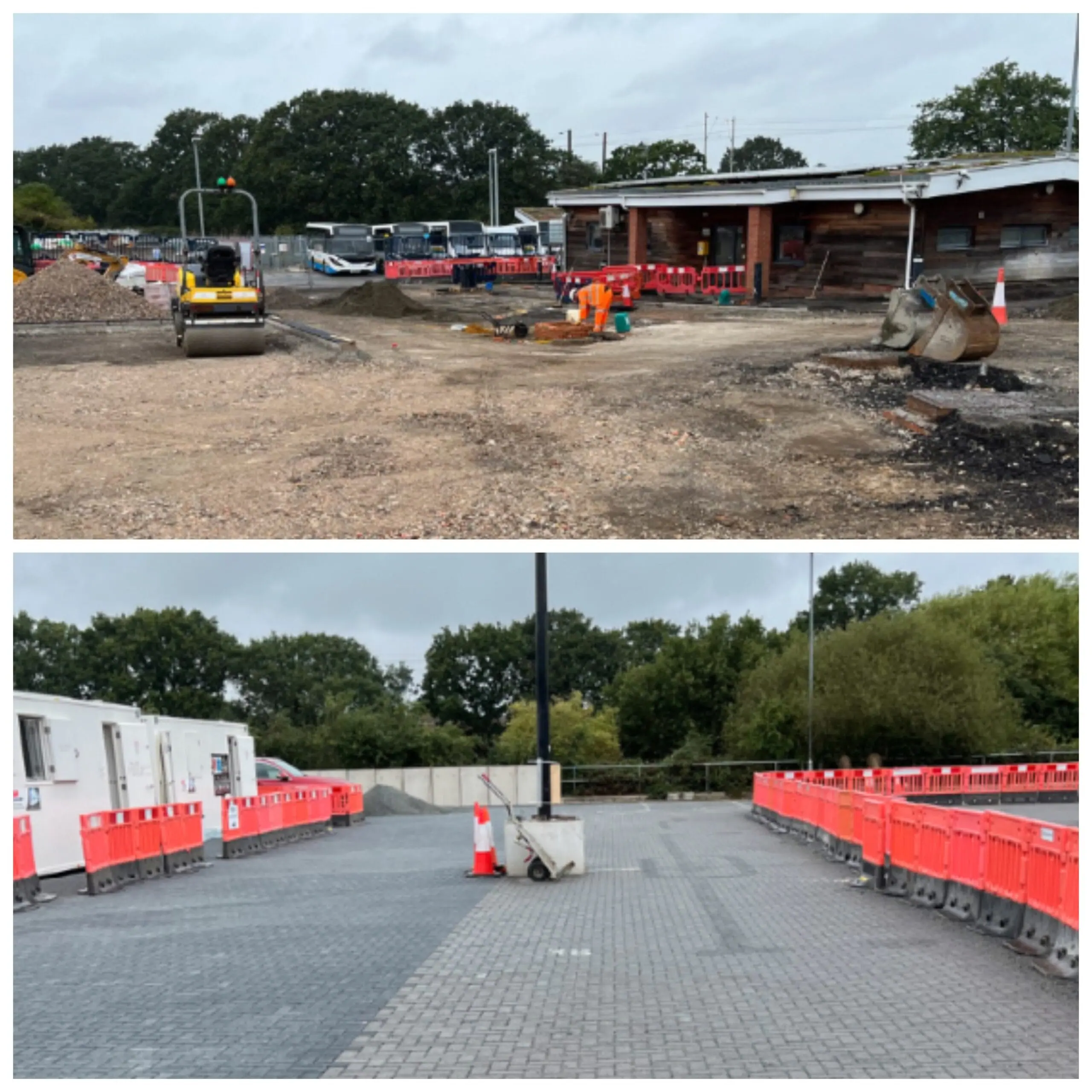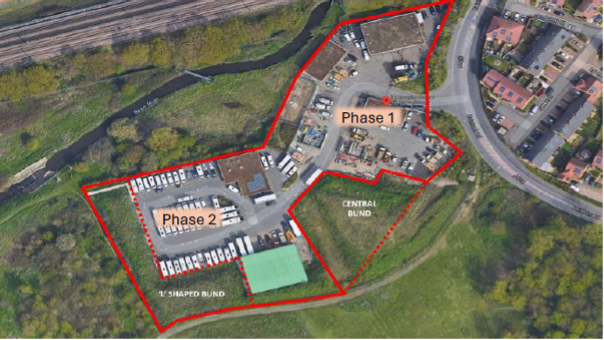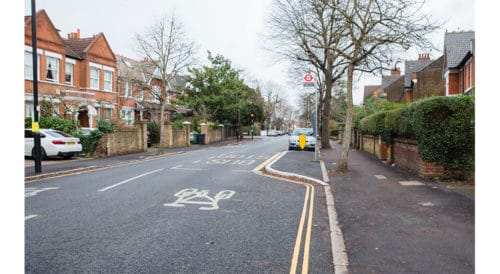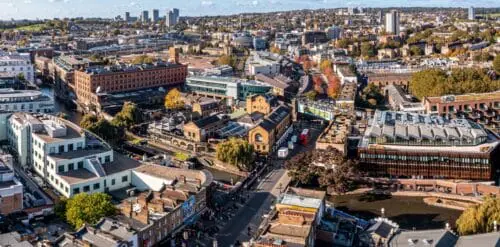Havering Central Depot Expansion Design by Metis | TKJV

Project Background
As part of the London Borough of Havering’s (Havering) waste contract tender, it was necessary to relocate Havering’s refuse fleet to their Central Depot. The London Borough of Havering invited Metis to provide a detailed design proposal, through Tarmac Kier Joint Venture (TKJV), for the expansion of the depot. The project was delivered in two phases. Phase 1 for the works around the Central bund area, and Phase 2 for areas around the L-shaped bund. The core proposal involved the extension of the existing parking area by removing the L-shaped bund, extending permeable paving blocks area, the removal of a portion of the Central bund for asphalt pavement extension.

Challenges and Opportunities
Programme Constraints: Meeting the set site handover date and planning requirements within strict timeframes demanded precise planning and execution.
Critical Underground Assets: Designing around critical underground assets such as gas mains, electric, and Thames Water assets required careful coordination and design adjustments.
Improved Parking Layouts: To accommodate up to 34 refuse vehicles at Phase 1 and an additional 11 vehicles parking capacity at Phase 2, an improved parking layout was essential.
Level Differences and Surface Unevenness: The significant level differences between the site fence line and adjacent land, along with surface unevenness at Phase 1, required surface reprofiling and strategic design solutions. This was essential in reducing site excavation while making the most of available space.
Flooding Issues: There were some flooding issues reported around office building lines at Phase 1, necessitating drainage improvements and flood mitigation measures.
Securing Planning Consent: Obtaining planning consent for Phase 1 expansion within a limited timeframe was key to ensure a timely delivery of the scheme.
Solutions
- Review of Information and Surveys: Upon review, we identified gaps in the pre-construction information provided and requested additional surveys using existing framework mechanism.
- Proposed Design: Collaboratively working with TKJV and Havering in developing a design strategy that considered site investigation data, vehicle specifications including heavy vehicles loading and large size vehicles, and various planning conditions.
- Asset Protection and Value Engineering: As part of our CDM responsibility as designers, we undertook risk assessment, provided and coordinated design packages with stakeholders and statutory undertakers. We identified underground assets and avoided costly diversions. For example, in Phase 2, we limited the parking area and implemented a retaining wall solution in order to maintain existing manhole cover levels.
- Drainage Design: We maintained and introduced additional surface channels in Phase 1 due to an increased catchment area. And at Phase 2, extended the use of a permeable block paving as a SuDS feature.
- Stakeholder Management: We ensured that the client’s brief and stakeholder requirements were met, and proposals coordinated through periodic meetings and workshops.
- Health, Safety and Welfare: We carried out risk assessments, and informed the construction logistic plans through design coordination with the contractor to ensure the welfare and site safety of all parties were met.
- Sustainability Consideration: Our designs considered various sustainability aspects, in line with existing planning conditions, the United Nations Sustainable Development Goals (UNSDGs), and the ICE’s sustainability policy. Some of the UNSDGs achieved are as follows:
-
- Goal 9: Specified off-the-shelf items like recycled material vehicle stoppers, surface channels, permeable blocks, reducing procurement lead times and material costs.
- Goal 11: Proposed reusing existing paving blocks and ensured lighting columns had shades to prevent light spillage into residential areas.
- Goal 12: Recommended CCTV drainage surveys to identify problem areas for repairs instead of major replacements, reducing material wastage, construction costs, and procurement risks.
- Goal 14: in addition to introducing surface drainage solutions at low points, existing oil separators/interceptors were maintained to improve efficiency.
- Goal 15: Reviewed habitat survey reports and implemented measures to minimise impacts on natural ecology, including handling potentially protected species.
Our Added value
In providing sustainable design solutions to our clients, we were able to save on material and construction costs whilst meeting our client’s objectives. We also maximised the use of available land space at the depot, increasing its capacity and functionality, thereby improving existing depot usage and meeting waste contractor requirements.
Through exceptional consultation support, we aided in the discharge of existing planning conditions. Our collaborative approach with TKJV and Havering throughout the duration of the project allowed us to effectively manage risk using the existing framework mechanism.
In adhering to our core values, we ensured that the design services we provided were highly valued by our client and done to best practices.
Outcomes and Achievements
The project successfully addressed challenges in relocating Havering’s refuse fleet by expanding the Central Depot to accommodate additional refuse vehicles as stated on the client brief.
Other outcomes include:
- Improved site drainage.
- Cost savings achieved by effectively managing stakeholders.
- Environmental considerations such as recycling materials and minimising ecological impacts.
- Completion of the project under budget, while meeting planning conditions, standards, and regulations.
Achievements:
We take pride in the opportunity to have supported LB Havering in delivering this project, which has an immense socio-economic impact on the borough’s local population. Our efforts ensured that the need for waste management for both the refuse contractors and local demands were met through the following:
- Improved sanitation – promoting good health and well-being.
- Contribution to sustainable cities and communities.
- Reduced inequalities and fostered collaboration for growth, aligning with the UNSDGs and LB Havering’s sustainable waste management planning strategy.
Interested in learning more about our work?
Explore some of our other Metis case studies to discover our recent projects. Or, if you’re seeking an experienced and passionate civil and environmental engineering team to partner with on your next project, please get in touch with us today.
PROJECT CONTACT
Matthew Elliman
Highway Engineering Team Lead
E: info@metisconsultants.co.uk
T: 02089480249

CLIENT
London Borough of Havering




